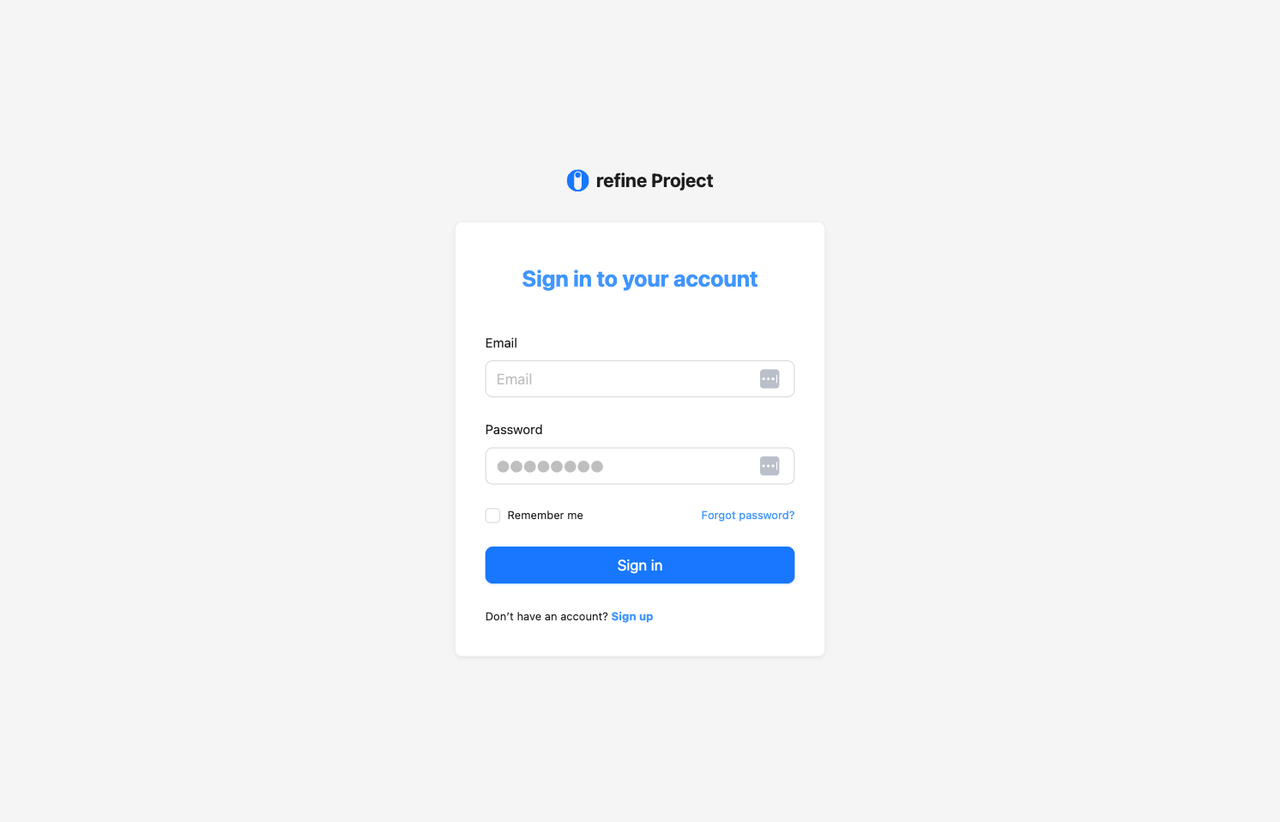Authentication provider
Upon creating a new project with Appwrite preset, the CLI automatically creates Auth Provider file.
You'll see a file named src/authProvider.ts created by CLI. This auto-generated file contains pre-defined functions using Appwrite Authentication methods internally to perform authentication and authorization operations.
The auth provider registered to the Refine app by default in the src/App.tsx.
import { authProvider } from './authProvider';
...
<Refine
...
authProvider={authProvider}
>
Now, we can configure the routing and auth components to manage logins and sign ups.
Routing
Refine offers router bindings and utilities for React Router v6 and improves the user interface with the routerProvider prop. This allows the framework to identify resources from routes and efficiently handle query parameters and navigation tasks.
import routerProvider from '@refinedev/react-router-v6';
import { BrowserRouter } from 'react-router-dom';
import { authProvider } from './authProvider';
...
<BrowserRouter>
<Refine
...
authProvider={authProvider}
routerProvider={routerProvider}
>
...
</BrowserRouter>
Login page
We'll use Routes component to connect routing mechanisim along with AuthPage component which returns ready-to-use authentication pages for login, register, update, and forgot password actions.
Update src/App.tsx to the following code.
import { Authenticated, Refine } from "@refinedev/core";
import { dataProvider, liveProvider } from "@refinedev/appwrite";
import {
AuthPage,
ErrorComponent,
RefineThemes,
ThemedLayoutV2,
useNotificationProvider,
} from "@refinedev/antd";
import routerProvider, {
CatchAllNavigate,
NavigateToResource,
} from "@refinedev/react-router-v6";
import "@refinedev/antd/dist/reset.css";
import { App as AntdApp, ConfigProvider } from "antd";
import { BrowserRouter, Outlet, Route, Routes } from "react-router-dom";
import { appwriteClient } from "./utility";
import { authProvider } from "./authProvider";
const App: React.FC = () => (
<BrowserRouter>
<ConfigProvider theme={RefineThemes.Blue}>
<AntdApp>
<Refine
dataProvider={dataProvider(appwriteClient, {
databaseId: "<APPWRITE_DATABASE_ID>",
})}
liveProvider={liveProvider(appwriteClient, {
databaseId: "<APPWRITE_DATABASE_ID>",
})}
authProvider={authProvider}
routerProvider={routerProvider}
notificationProvider={useNotificationProvider}
>
<Routes>
<Route
element={
<Authenticated
fallback={<CatchAllNavigate to="/login" />}
>
<ThemedLayoutV2>
<Outlet />
</ThemedLayoutV2>
</Authenticated>
}
></Route>
<Route
element={
<Authenticated fallback={<Outlet />}>
<NavigateToResource
resource="<APPWRITE_TABLE_ID>"
/>
</Authenticated>
}
>
<Route
path="/login"
element={<AuthPage forgotPasswordLink={false} />}
/>
<Route path="/register"
element={<AuthPage type="register" />}
/>
</Route>
<Route
element={
<Authenticated>
<ThemedLayoutV2>
<Outlet />
</ThemedLayoutV2>
</Authenticated>
}
>
<Route path="*" element={<ErrorComponent />} />
</Route>
</Routes>
</Refine>
</AntdApp>
</ConfigProvider>
</BrowserRouter>
);
export default App;
Key concepts to handle authentication and routing:
- The
<AuthPage>component in Refine includes pages for login, registration, password reset, and password update functionalities. - To manage authenticated routes effectively, the
<Authenticated>component using to determine the user's authentication status and accordingly directs them or displays relevant elements. - Within the
<Authenticated>component, we use the<Outlet>component fromreact-router-domto render secure routes that are accessible only to authenticated users. - We set up a
/loginroute for redirecting unauthenticated users, using Refine's AuthPage components with atype="login"prop to create the login page efficiently.
When you refresh the page, the login screen appears.

We'll activate the authentication mechanisim with Appwrite in the next section.